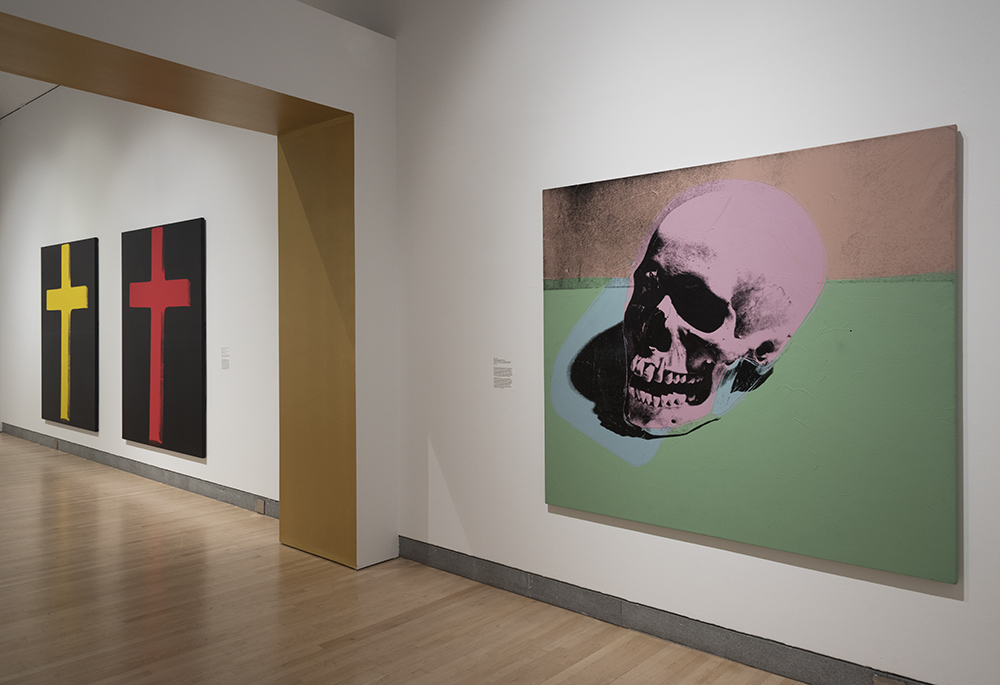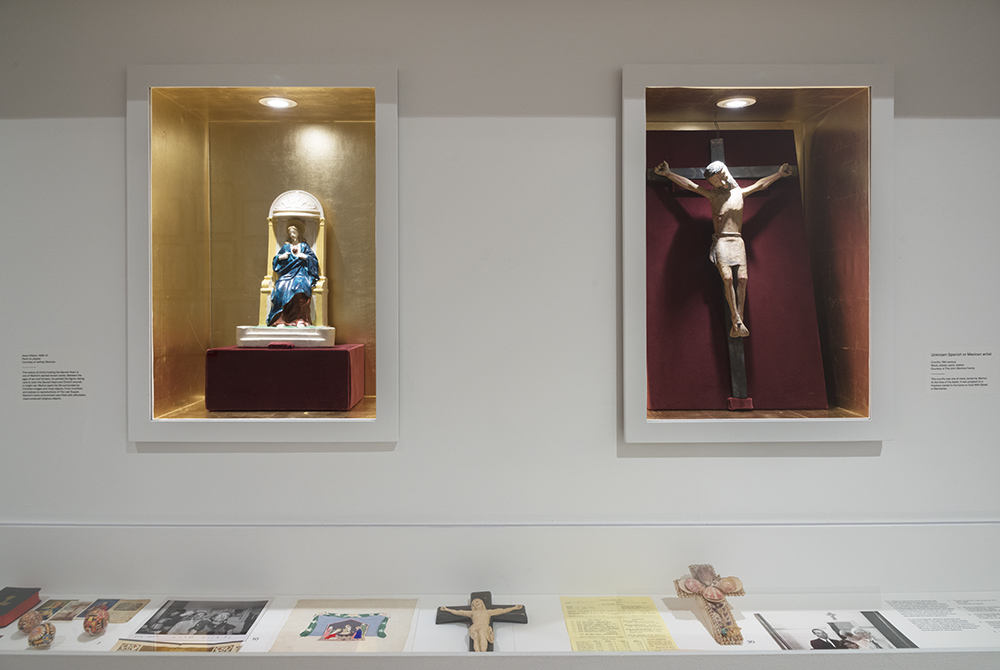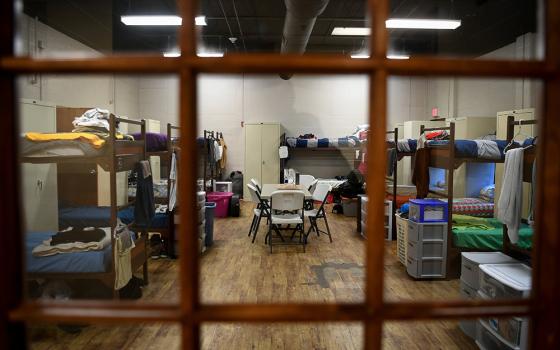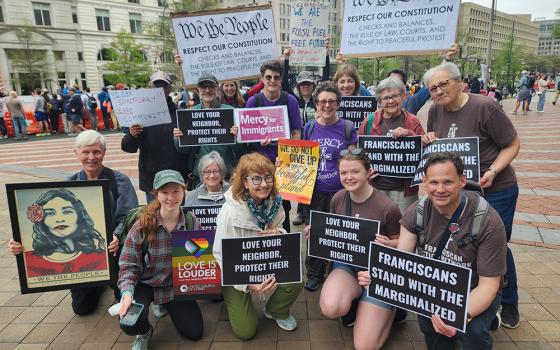
Installation view of "Andy Warhol: Revelation," at the Brooklyn Museum Nov. 19, 2021-June 19, 2022 (Courtesy photo: Brooklyn Museum/Jonathan Dorado. Artworks by Andy Warhol © 2021 The Andy Warhol Foundation for the Visual Arts, Inc./Licensed by Artists Rights Society (ARS), New York. Used with permission of @warholfoundation)
"Andy Warhol: Revelation," now open at the Brooklyn Museum through June 2022, examines Warhol's iconic works from an oft-overlooked perspective: his Catholic faith.
Developed by the Andy Warhol Museum's chief curator José Carlos Diaz and curated at the Brooklyn Museum by Carmen Hermo, "Revelation," takes Warhol's brightly-colored Marilyn Monroes, Jackie Kennedys, Mona Lisas and more and displays them alongside lesser-known works with more overt Catholic themes, depicting a wonderful foray into contemporary American Catholicism in all its messy glory.
The exhibit follows a recent development in art history seeking to reinterpret Warhol's work through an autobiographical lens. Some fantastic items have been pulled from the Andy Warhol Museum in Pittsburgh, Pennsylvania, including drawings by Warhol's mother (Julia Warhola), prayer cards and photographs with Pope John Paul II. Some of the most show-stopping highlights include Warhol's two gigantic versions of "The Last Supper" in pink and yellow, shown together for the first time. Visitors also get to see some of Warhol's films, which play on loop throughout the gallery.
It is perhaps one of the first major shows to investigate postwar American Catholic culture, and one of the first to celebrate how Warhol brought his gay and Catholic identities into conversation with each other. There is a clear intention to talk about Catholicism as a lived faith, not just an abstract set of teachings, and the complicated realities present-day Catholics face in a modernized, globalized society.
Noteworthy differences between the Pittsburgh premiere of "Revelation" and its Brooklyn installation alter the show's messaging to mixed success. The original exhibition (which I did not get to see) took inspiration from Warhol's film "**** (Four Stars)," specifically a single reel of footage Warhol shot for an unrealized Vatican-funded project. Using the spiritual themes of the film to discuss Warhol's own religious beliefs, "Revelation" was structured with thematic sections examining Warhol as a devout but tortured Catholic. The Brooklyn Museum reorders the show's sections and changes the exhibition checklist. "Four Stars" is an afterthought installed between sequential sections of the exhibition, and a stronger focus on New York (bolstered by insertions of a co-authored Jean-Michel Basquiat work, "The Chelsea Girls," and a stunning Richard Avedon photograph) destabilizes the Catholic focus and presents Warhol more as a Jesus figure within the New York art scene.

Installation view of "Andy Warhol: Revelation," at the Brooklyn Museum Nov. 19, 2021-June 19, 2022 (Courtesy photo: Brooklyn Museum/Jonathan Dorado. Artworks by Andy Warhol © 2021 The Andy Warhol Foundation for the Visual Arts, Inc./Licensed by Artists Rights Society (ARS), New York. Used with permission of @warholfoundation)
This is perhaps most evident in the strong emphasis on Warhol's relationship with his mother. Various Madonnas with children appear throughout the first third of the exhibition, and it is no coincidence this is also when Warhol's relationship with his mother gets discussed. It is impossible to not see Andy and Julia's intimate relationship akin to Jesus and Mary. Between this, a somewhat uncritical look at Warhol's treatment of women and the briefest mention of Warhol's complicated relationship to AIDS, Warhol comes off more as a spotless victim than as a conflicted believer.
Warhol's apotheosis is cemented through the insertion of Richard Avedon's "Andy Warhol, Artist, New York City," on loan from the Metropolitan Museum of Art. This larger-than-life photograph shows Warhol's scarred torso not long after he was shot by former collaborator Valerie Solanas in retribution for his mistreatment of her during film projects. The incident is recounted in broad strokes to cast Warhol as a sacrificial lamb to Solanas' radical, feminist rage. Reconstructive surgeries left scars and cavities across Warhol's body, which Avedon captures in dramatic aesthetic. The photograph is arresting. Though the accompanying wall text explicitly avoids any Christ-like connections (referencing St. Sebastian), between the Madonna and Child allusions and lopsided retelling of his feud with Solanas, Warhol seems framed as a scorned prophet.
The reorganization of "Revelation" for the Brooklyn Museum also leaves the final section of the show a little lacking. A loose collection of "What We Worship" features Warhol's "Orange Disaster/Electric Chair," excerpts from the "Race Riot" series, and a selection from the "Dollar Sign" series among leftovers from the exhibition checklist. The section generically laments American obsessions with race, money and death. While these issues are absolutely worth discussing, the way they are presented seems more an afterthought cobbled together from the scraps of a show that — in its original form — holistically incorporated them into other sections. Throughout the show, American and Catholic identities poetically meld into each other; ending the exhibition with a hard pivot to secular culture as distinct from religious culture undoes this work.
Advertisement
The show (both its original and revised forms) misses a valuable opportunity to discuss Byzantine and Roman Catholic visual cultures and how Warhol's work navigates tensions between the two. Byzantine Catholic iconography (an obvious connection to the "iconography" of Warhol's celebrities) is produced through rituals of prayer and meditation and use of precious materials. In contrast, Roman Catholic visual culture prioritizes quick production, simple design and clear messaging. Given Warhol's fascination with reproduction, repetition and commodification, it would have been interesting for "Revelation" to demonstrate more nuance with an acknowledgment of how these contrasting histories play into Warhol's work. Great pivot pieces for this conversation such as Warhol's "Eggs" series might have helped, but unfortunately they were not included at the Brooklyn Museum.
Despite its shortcomings, in "Revelation" Warhol's work and American Catholicism also emerge as more complicated and profound than before.
"Revelation" is a thought-provoking foray into a new kind of Warhol. The show strikes an appropriate balance of being accessible for those unfamiliar with Catholic culture and extensive enough to get Catholics thinking critically about lived experiences of faith.






